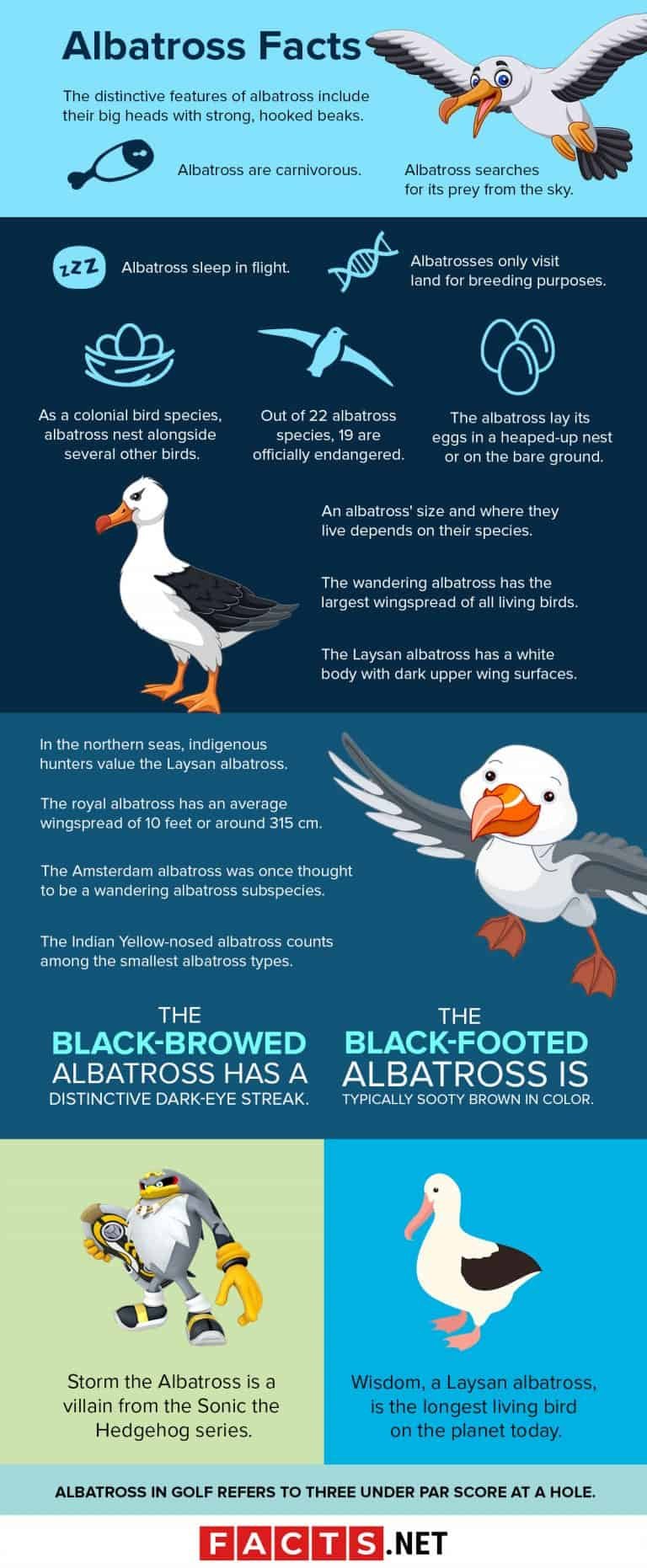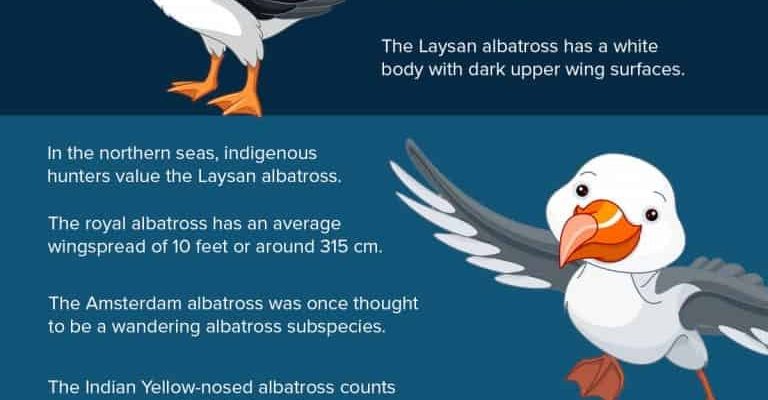
Albatrosses are more than just beautiful sights; they’re fascinating creatures with unique traits and behaviors that set them apart from other birds. Whether you’re a birdwatcher or just curious about the world around you, learning about these amazing animals can deepen your appreciation of nature. So, grab a cup of coffee, and let’s dive into some of the most captivating facts about the albatross!
1. The Enormous Wingspan
One of the first things that capture your attention about albatrosses is their wingspan. The wandering albatross, in particular, boasts the longest wingspan of any living bird, stretching up to 12 feet (3.6 meters). Imagine trying to fit that in your living room! These impressive wings allow them to glide for hours with minimal effort, soaring above the water’s surface as they search for food.
Here’s the thing: albatrosses can travel thousands of miles without flapping their wings much. They harness wind currents and thermal updrafts to stay aloft, conserving energy during their long flights. This incredible adaptation not only helps them cover vast distances—foraging in various territories—but it also allows them to roam over the ocean for days at a time without needing to rest.
So, next time you see an albatross gliding, remember that it’s not just a bird; it’s a master of flight, showcasing nature’s design at its best.
2. Long-Distance Travelers
Albatrosses are renowned for their long-distance travels. Some species can fly over 10,000 miles (16,000 kilometers) in a single journey. That’s like flying from New York to Sydney without stopping for a snack! They often migrate between breeding grounds and foraging areas, covering expansive ocean territories.
These birds are known to utilize the wind patterns of the Southern Ocean to help them navigate their incredible journeys. You might be wondering, how do they know where to go? Well, albatrosses have excellent navigation skills. They rely on their keen eyesight and innate sense of direction, along with the Earth’s magnetic field, to guide them over the vast seas.
Despite their size and strength, these long-distance travelers face challenges. Changes in sea temperature and wind patterns can affect their food sources, making their journeys more complex. As climate change impacts the oceans, researchers are keenly studying how these majestic birds will adapt.
3. Unique Feeding Habits
When it comes to feeding, albatrosses have some unique habits. They primarily eat fish, squid, and krill, often scouring the ocean’s surface for food. What’s fascinating is their ability to locate prey from great heights. They can spot a school of fish from hundreds of feet in the air, thanks to their excellent vision.
Albatrosses are also known to follow ships, hoping to catch scraps thrown overboard. Imagine being that bird, gliding above, spotting a meal without even flapping your wings! This behavior highlights their adaptability and intelligence in finding food sources.
However, their feeding habits can put them at risk. Accidental capture in fishing gear is a significant threat they face. Conservation efforts are underway to reduce bycatch and ensure that these magnificent birds continue to grace our oceans for generations to come.
4. Strong Mates for Life
Albatrosses are known for their monogamous relationships, often staying with the same partner for life. Once they choose a mate, they engage in elaborate courtship displays that include synchronized flying and vocalizations. These rituals help strengthen their bond, showcasing their commitment to each other.
Here’s a fun story: some albatrosses even engage in “dancing” together during these courtship displays. They’ll flap their wings, bob their heads, and even touch beaks. This display isn’t just a cute act but a vital part of their mating ritual, reinforcing their connection before they start raising chicks.
Once they do start a family, the couple shares parenting duties. Albatrosses typically lay just one egg every two years, making each breeding season crucial for their survival. Raising a chick takes a lot of effort, and both parents take turns incubating the egg and caring for the hatchling. This commitment highlights their strong partnerships, showing that love and teamwork are essential in the animal kingdom.
5. Impressive Lifespan
Albatrosses enjoy a surprisingly long lifespan, often living to be 50 years or older. Some individuals have been known to live beyond 60 years! That’s like having a grandparent who has seen and experienced a lot of history. Their longevity is partly due to their lifestyle; they spend much of their lives gliding over the ocean, where they aren’t exposed to many predators.
This long lifespan also allows them to become expert navigators and parents. Older birds tend to have better success in raising their young, as they’ve honed their skills over the years. However, with age comes vulnerability. Human impact, such as pollution and climate change, poses challenges that could affect their longevity.
As albatrosses age, they still face the same risks as younger birds, but their experience makes them resilient. Protecting their habitats and food sources is vital to ensuring these ancient mariners can continue to thrive.
6. A Symbol of Good Luck
In many cultures, the albatross is viewed as a symbol of good luck. Sailors have long held the belief that these birds bring favorable winds and safe passage. Spotting an albatross while at sea was often seen as an omen of success, inspiring awe and respect among seafarers.
The connection between albatrosses and good fortune is depicted in literature and art as well. Samuel Taylor Coleridge’s famous poem, “The Rime of the Ancient Mariner,” features an albatross, representing fate and nature’s interconnectedness. This storytelling aspect adds to the bird’s mystique, elevating its status in the human imagination.
However, this view also carries a warning. Killing an albatross or harming its habitat is often considered bad luck—hence the phrase “an albatross around one’s neck.” This expression symbolizes a burden or curse, reflecting the deep respect some cultures hold for these creatures.
7. Vulnerable to Threats
Despite their majestic nature, albatrosses face numerous threats that have put their populations at risk. Many species are classified as vulnerable or even endangered. The primary challenges they encounter include habitat loss, climate change, and accidental capture in fishing gear.
Fishing practices like longlining can inadvertently catch albatrosses, leading to injury or death. Entanglement in discarded fishing gear is another significant concern. Here’s the thing: as humans, we have a responsibility to protect these magnificent birds. Awareness of these issues can help foster conservation efforts.
Conservation groups and researchers are working hard to implement strategies that minimize bycatch and protect their habitats. Initiatives like “bird-friendly” fishing practices aim to balance the needs of fisheries with the survival of seabird populations. It’s a step in the right direction!
8. Conservation Efforts and the Future
Conservation efforts focused on albatross protection are crucial for their survival. Many organizations are actively working to safeguard their habitats and minimize human impact. This includes establishing marine protected areas, reducing plastic pollution, and advocating for sustainable fishing practices.
Avian conservationists often engage in public education to promote awareness about the challenges these birds face. Many initiatives aim to involve local communities and fishermen in protecting albatrosses and their environments. It’s a collaborative effort that highlights the importance of preserving our oceans.
By supporting these conservation efforts, we can contribute to the future of albatrosses and ensure that they continue to soar gracefully over our oceans. Every little bit helps, whether by reducing plastic waste or spreading the word about their plight.
9. Fascinating Adaptations
Albatrosses are equipped with some incredible adaptations that make them uniquely suited to their oceanic lifestyle. Their large wings not only help them cover vast distances but also allow them to glide effortlessly over the waves. They have specialized nostrils that help them locate food from miles away, detecting subtle changes in the ocean’s surface.
Their body structure is finely tuned for life at sea. With strong, webbed feet, they are agile when waddling on land but are primarily designed for flight. You might be surprised to learn that their legs are positioned further back on their body, which helps them maneuver while gliding and diving into the water for food.
Additionally, albatrosses have a unique way of conserving water. They have adapted to drink seawater and excrete the excess salt through special glands in their nasal passages. This ability allows them to thrive in the harsh, salty environment of the open ocean, ensuring they stay hydrated during their long flights.
10. An Ongoing Mystery
Despite all we know about albatrosses, many aspects of their lives remain a mystery. Scientists are still studying their migration patterns, breeding behaviors, and how they respond to changes in their environment. The more we learn, the more we realize how complex and interconnected their lives are.
Researchers often use tracking technology to monitor their movements. This technology helps us understand where they go and how they interact with their surroundings. Every year, new discoveries shed light on their behaviors, fostering interest and concern for their conservation.
As we uncover the secrets of the albatross, it’s clear that these birds are more than just beautiful creatures soaring over the ocean. They remind us of the delicate balance of nature and the importance of protecting our natural world.
In conclusion, understanding the albatross helps us appreciate the beauty and complexity of our planet’s ecosystems. From their impressive wingspans to their remarkable resilience, these birds are truly fascinating. By learning more about them, we can contribute to their conservation and ensure these magnificent birds continue to inspire future generations. So, the next time you see an albatross gliding through the sky, take a moment to reflect on its journey and the mysteries it carries.

